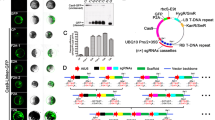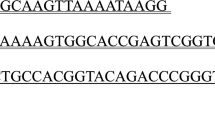Abstract
Targeted genome editing using CRISPR/Cas9 is a promising technology successfully verified in various plant species; however, it has hardly been used in plant cell suspension cultures. Here, we describe a successful knockout of a green fluorescent protein (gfp) reporter gene in Arabidopsis cell culture. We transformed seven transgenic suspension cell lines carrying one to three gfp gene copies with a binary vector containing genes coding for Cas9 and guide RNAs targeting the gfp gene. We detected the site-specific mutations by restriction analysis of a gfp amplicon. DNA sequencing of the PCR products confirmed high diversity of insertion-deletion mutations in the cell lines after the editing. We also analyzed gfp mRNA expression by real-time PCR and observed a decrease in gfp transcription after the target site modification. We can conclude that the CRISPR/Cas9 system can be successfully used for introducing site-specific mutations into the genome of cultured suspension cells of Arabidopsis.





Similar content being viewed by others
References
Datsenko K, Pougach K, Tikhonov A et al (2012) Molecular memory of prior infections activates the CRISPR/Cas adaptive bacterial immunity system. Nat Commun 3:945. https://doi.org/10.1038/ncomms1937
Garneau JE, Dupuis MÈ, Villion M et al (2010) The CRISPR/cas bacterial immune system cleaves bacteriophage and plasmid DNA. Nature 468:67–71. https://doi.org/10.1038/nature09523
Hsu PD, Scott DA, Weinstein JA et al (2013) DNA targeting specificity of RNA-guided Cas9 nucleases. Nat Biotechnol 31:827–832. https://doi.org/10.1038/nbt.2647
Arora L, Narula A (2017) Gene editing and crop improvement using CRISPR-Cas9 system. Front Plant Sci. https://doi.org/10.3389/fpls.2017.01932
Demirci Y, Zhang B, Unver T (2018) CRISPR/Cas9: an RNA-guided highly precise synthetic tool for plant genome editing. J Cell Physiol 233:1844–1859. https://doi.org/10.1002/jcp.25970
Soyars CL, Peterson BA, Burr CA, Nimchuk ZL (2018) Cutting edge genetics: CRISPR/Cas9 editing of plant genomes. Plant Cell Physiol 59:1608–1620. https://doi.org/10.1093/pcp/pcy079
Yu Z, Chen Q, Chen W et al (2017) Multigene editing via CRISPR/Cas9 guided by a single-sgRNA seed in Arabidopsis. J Integr Plant Biol 60:376–381. https://doi.org/10.1111/jipb.12622
Durr J, Papareddy R, Nakajima K, Gutierrez-Marcos J (2018) Highly efficient heritable targeted deletions of gene clusters and non-coding regulatory regions in Arabidopsis using CRISPR/Cas9. Sci Rep 8:1–11. https://doi.org/10.1038/s41598-018-22667-1
Schiml S, Fauser F, Puchta H (2014) The CRISPR/Cas system can be used as nuclease for in planta gene targeting and as paired nickases for directed mutagenesis in Arabidopsis resulting in heritable progeny. Plant J 80:1139–1150. https://doi.org/10.1111/tpj.12704
Peterson BA, Haak DC, Nishimura MT et al (2016) Genome-wide assessment of efficiency and specificity in CRISPR/Cas9 mediated multiple site targeting in arabidopsis. PLoS ONE 11:1–11. https://doi.org/10.1371/journal.pone.0162169
Zhao C, Zhang Z, Xie S et al (2016) Mutational evidence for the critical role of CBF genes in cold acclimation in Arabidopsis. Plant Physiol. https://doi.org/10.1104/pp.16.00533
Tekoah Y, Shulman A, Kizhner T et al (2015) Large-scale production of pharmaceutical proteins in plant cell culture-the protalix experience. Plant Biotechnol J 13:1199–1208. https://doi.org/10.1111/pbi.12428
Santos RB, Abranches R, Fischer R et al (2016) Putting the spotlight back on plant suspension cultures. Front Plant Sci 7:1–12. https://doi.org/10.3389/fpls.2016.00297
Xu J, Dolan MC, Medrano G et al (2011) Green factory: plants as bioproduction platforms for recombinant proteins. Biotechnol Adv 30:1171–1184. https://doi.org/10.1016/j.biotechadv.2011.08.020
Zagorskaya AA, Deineko EV (2017) Suspension-cultured plant cells as a platform for obtaining recombinant proteins. Russ J Plant Physiol 64:795–807. https://doi.org/10.1134/S102144371705017X
Rozov SM, Permyakova NV, Deineko EV (2018) Main strategies of plant expression system glycoengineering for producing humanized recombinant pharmaceutical p roteins. Biochemistry (Mosc) 83:215–232. https://doi.org/10.1134/S0006297918030033
Hanania U, Ariel T, Tekoah Y et al (2017) Establishment of a tobacco BY2 cell line devoid of plant-specific xylose and fucose as a platform for the production of biotherapeutic proteins. Plant Biotechnol J 15:1120–1129. https://doi.org/10.1111/pbi.12702
Mercx S, Smargiasso N, Chaumont F et al (2017) Inactivation of the β(1,2)-xylosyltransferase and the α(1,3)-fucosyltransferase genes in Nicotiana tabacum BY-2 cells by a multiplex CRISPR/Cas9 strategy results in glycoproteins without plant-specific glycans. Front Plant Sci 8:1–11. https://doi.org/10.3389/fpls.2017.00403
Mercx S, Tollet J, Magy B et al (2016) Gene inactivation by CRISPR-Cas9 in Nicotiana tabacum BY-2 suspension cells. Front Plant Sci 7:40. https://doi.org/10.3389/fpls.2016.00040
Ren C, Liu X, Zhang Z et al (2016) CRISPR/Cas9-mediated efficient targeted mutagenesis in Chardonnay (Vitis vinifera L.). Sci Rep 6:32289. https://doi.org/10.1038/srep32289
Jiang C, Mithani A, Gan X et al (2011) Regenerant arabidopsis lineages display a distinct genome-wide spectrum of mutations conferring variant phenotypes. Curr Biol. https://doi.org/10.1016/j.cub.2011.07.002
Polanco C, Ruiz ML (2002) AFLP analysis of somaclonal variation in Arabidopsis thaliana regenerated plants. Plant Sci. https://doi.org/10.1016/s0168-9452(02)00029-8
Sedov KA, Fomenkov AA, Solov’yova AI et al (2014) The level of genetic variability of cells in prolonged suspension culture of Arabidopsis thaliana. Biol Bull 41:493–499. https://doi.org/10.1134/S1062359014060107
Michno J-M, Wang X, Liu J et al (2015) CRISPR/Cas mutagenesis of soybean and Medicago truncatula using a new web-tool and a modified Cas9 enzyme. GM Crops Food 6:243–252. https://doi.org/10.1080/21645698.2015.1106063
Marenkova TV, Sidorchuk YV, Nosov AV et al (2019) The variation in gfp gene expression in Arabidopsis thaliana monoclonal cell lines. Biotekhnologiya 35 (in press)
Ogawa Y, Dansako T, Yano K et al (2008) Efficient and high-throughput vector construction and Agrobacterium-mediated transformation of Arabidopsis thaliana suspension-cultured cells for functional genomics. Plant Cell Physiol 49:242–250. https://doi.org/10.1093/pcp/pcm181
Schenk RU, Hildebrandt AC (1972) Medium and techniques for induction and growth of monocotyledonous and dicotyledonous plant sell cultures. Can J Bot 50:199–204
Allen GC, Flores-Vergara MA, Krasynanski S et al (2006) A modified protocol for rapid DNA isolation from plant tissues using cetyltrimethylammonium bromide. Nat Protoc 1:2320–2325. https://doi.org/10.1038/nprot.2006.384
Wu J-J, Liu Y-W, Sun M-X (2011) Improved and high throughput quantitative measurements of weak GFP expression in transgenic plant materials. Plant Cell Rep 30:1253–1260. https://doi.org/10.1007/s00299-011-1034-x
Bradford MM (1976) A rapid and sensitive method for the quantitation of microgram quantities of protein utilizing the principle of protein-dye binding. Anal Biochem 72:248–254
Schiml S, Puchta H (2016) Revolutionizing plant biology: multiple ways of genome engineering by CRISPR/Cas. Plant Methods 12:8. https://doi.org/10.1186/s13007-016-0103-0
Bortesi L, Fischer R (2015) The CRISPR/Cas9 system for plant genome editing and beyond. Biotechnol Adv 33:41–52. https://doi.org/10.1016/j.biotechadv.2014.12.006
Wang S, Zhang S, Wang W et al (2015) Efficient targeted mutagenesis in potato by the CRISPR/Cas9 system. Plant Cell Rep 34:1473–1476. https://doi.org/10.1007/s00299-015-1816-7
Butler NM, Atkins PA, Voytas DF, Douches DS (2015) Generation and inheritance of targeted mutations in potato (Solanum tuberosum L.) using the CRISPR/Cas system. PLoS ONE 10:1–12. https://doi.org/10.1371/journal.pone.0144591
Zhang Y, Liang Z, Zong Y et al (2016) Efficient and transgene-free genome editing in wheat through transient expression of CRISPR/Cas9 DNA or RNA. Nat Commun 7:1–8. https://doi.org/10.1038/ncomms12617
Hahn F, Nekrasov V (2018) CRISPR/Cas precision: do we need to worry about off-targeting in plants? Plant Cell Rep 38:437–441. https://doi.org/10.1007/s00299-018-2355-9
Kumlehn J, Pietralla J, Hensel G et al (2018) The CRISPR/Cas revolution continues: from efficient gene editing for crop breeding to plant synthetic biology. J Integr Plant Biol 60:1127–1153. https://doi.org/10.1111/jipb.12734
Khatodia S, Bhatotia K, Passricha N et al (2016) The CRISPR/Cas genome-editing tool: application in improvement of crops. Front Plant Sci 7:1–13. https://doi.org/10.3389/fpls.2016.00506
Schaeffer SM, Nakata PA (2016) The expanding footprint of CRISPR/Cas9 in the plant sciences. Plant Cell Rep. https://doi.org/10.1007/s00299-016-1987-x
Gilbert LA, Horlbeck MA, Adamson B et al (2014) Genome-scale CRISPR-mediated control of gene repression and activation. Cell 159:647–661. https://doi.org/10.1016/j.cell.2014.09.029
Didovyk A, Borek B, Tsimring L, Hasty J (2016) Transcriptional regulation with CRISPR-Cas9: principles, advances, and applications. Curr Opin Biotechnol 40:177–184. https://doi.org/10.1016/j.copbio.2016.06.003
Hahn F, Mantegazza O, Greiner A et al (2017) An efficient visual screen for CRISPR/Cas9 activity in Arabidopsis thaliana. Front Plant Sci 08:1–13. https://doi.org/10.3389/fpls.2017.00039
Klimek-Chodacka M, Oleszkiewicz T, Lowder LG et al (2018) Efficient CRISPR/Cas9-based genome editing in carrot cells. Plant Cell Rep 37:575–586. https://doi.org/10.1007/s00299-018-2252-2
Acknowledgements
The work was supported by the Russian Science Foundation (Project No. 17-14-01099). The English language was corrected and certified by shevchuk-editing.com.
Author information
Authors and Affiliations
Contributions
NVP and EVD conceived and designed research. NVP, YuVS, TVM, SAK, VVK and AAZ conducted experiments. VVK contributed new reagents or analytical tools. NVP, YuVS and VVK analyzed data. NVP and SMR wrote the manuscript. All authors read and approved the manuscript.
Corresponding author
Ethics declarations
Conflict of interest
The authors declare that they have no conflicts of interest.
Additional information
Publisher's Note
Springer Nature remains neutral with regard to jurisdictional claims in published maps and institutional affiliations.
Rights and permissions
About this article
Cite this article
Permyakova, N.V., Sidorchuk, Y.V., Marenkova, T.V. et al. CRISPR/Cas9-mediated gfp gene inactivation in Arabidopsis suspension cells. Mol Biol Rep 46, 5735–5743 (2019). https://doi.org/10.1007/s11033-019-05007-y
Received:
Accepted:
Published:
Issue Date:
DOI: https://doi.org/10.1007/s11033-019-05007-y




